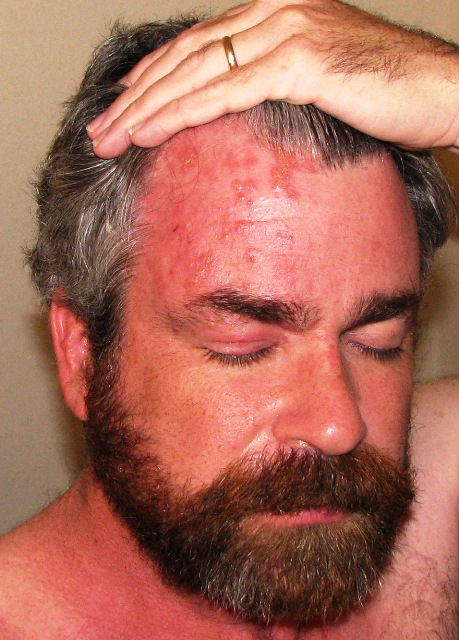WikiWikiPlanet.Com
It's About Everything!
Shingles on Forehead and EyeThis is an example of shingles on the forehead and around the eye of a 47 year old white male patient. The shingles are caused by the herpes zoster virus that causes chickenpox in children. Shingles typically occur in adults who had chickenpox as a child. This patient had chickenpox as a child. He and his doctor were taken by surprise though as shingles typically occur in adults who are over 60. The photographs were taken just 7 days after the first onset of any symptoms.
Symptoms began while the patient had a cold. Symptoms of this case of shingles started as a migrain-like headache and a tingling sensation in the nerves on the patient's forehead back into the scalp. Then the rash and blisters began to appear with a sensation that felt like a sunburn which progressively got worse. The rash and blisters on the scalp cannot be seen in the picture because of patient's hair. Eventually without pain medication the patient was unable to sleep. Typical of shingles, the headcahe, rash and blisters only occurred on one side of the body. Notice, the rash and blisters stop at the middle of the patient's forehead. Patient's shingles were treated with Acyclovir (an anti-viral drug) and pain medication. Shingles on the head can be dangerous. If you develop shingles around your eye, various medical sites on the Internet recommend that you consult a doctor immediately. Shingles around the eye can lead to partial or total blindness. As a result of the shingles, this patient developed a 2mm stromal edema in the cornea of his right eye which resulted in cloudy or foggy vision. The patient had halo vison at night when viewing lights. This vision problem developed about 5 weeks from the onset of shingles. The eye was treated with opthalmic corticosteroid eyedrops: at first Lotemax and later with Prednisolone.
|
Copyright WikiWikiPlanet 2008
www.WikiWikiPlanet.com
